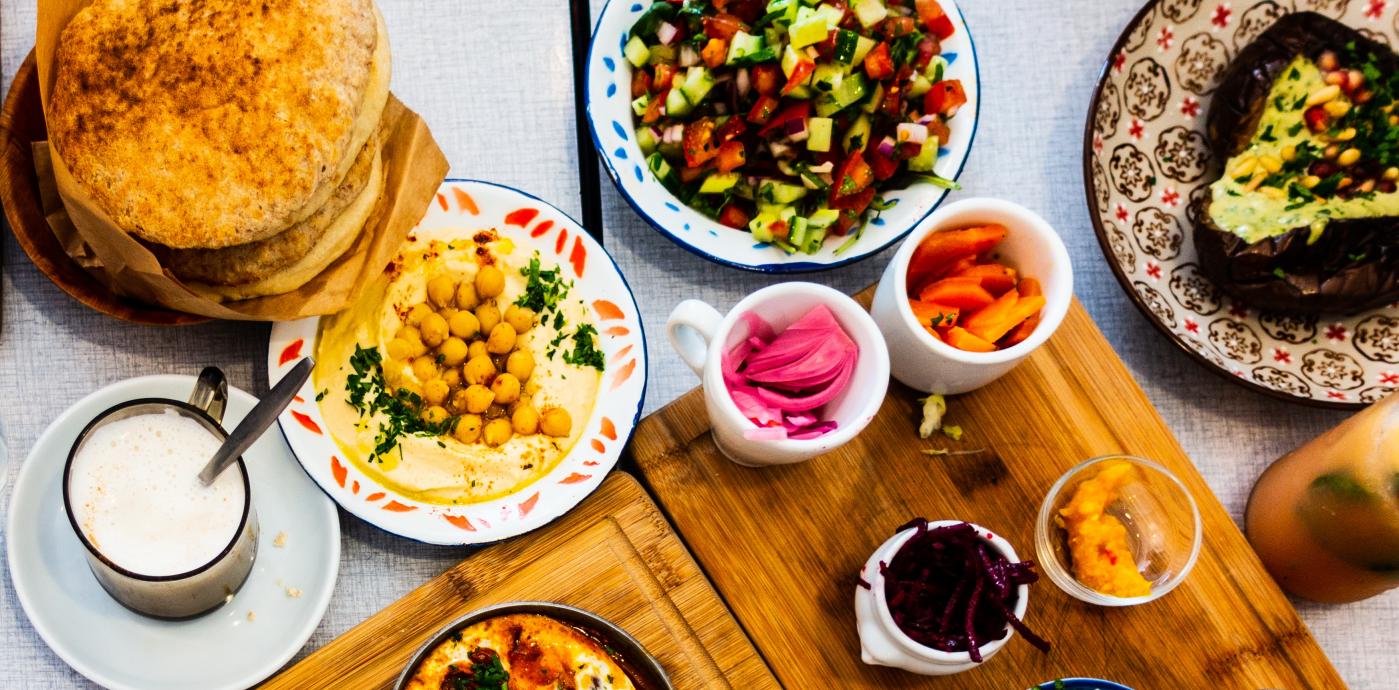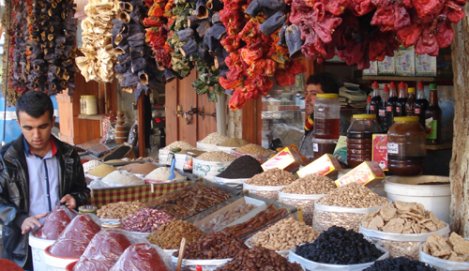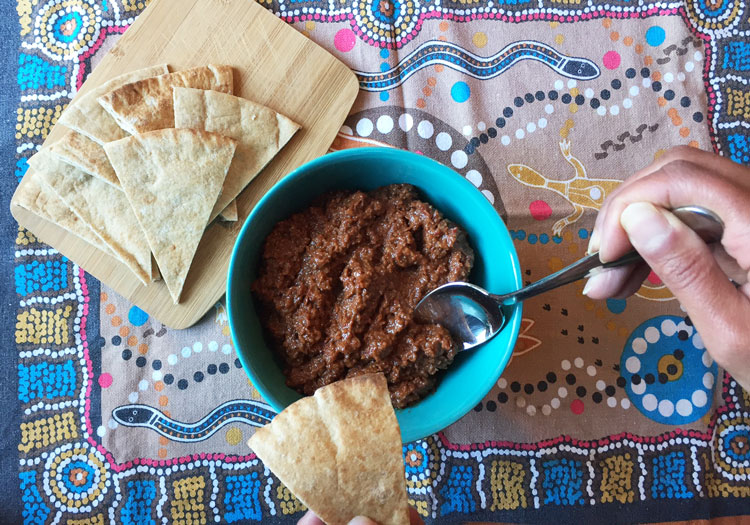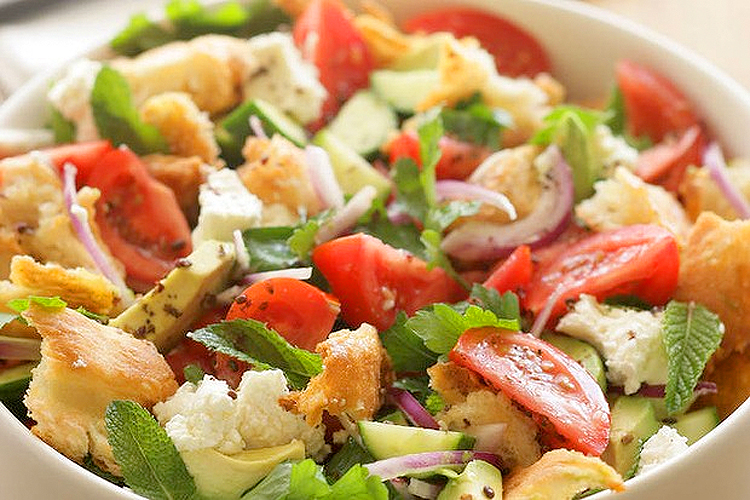Share This
When we think about the Mediterranean, our minds might instantly conjure up images of the turquoise or blue-emerald green waters surrounding the Greek islands, the rolling green hills of the Tuscan countryside dotted with Cypress trees, or the lavender fields in Provence. However, there are a vast number of countries that call the Mediterranean their home. If you look on a map and follow east from Greece, you’ll see that Turkey, Syria, Lebanon, Israel, Palestine, Egypt, and the island of Cyprus form the eastern border of the Mediterranean Sea.
While the Mediterranean Diet is often defined as a unified culinary cuisine with shared traditions, there is a significant degree of cultural variance in cooking to be found in this geographic region. The aforementioned eastern countries are part of the Mediterranean and are also rooted in Levant flavors—a geographic term that refers to an area in the Middle East which historically includes Palestine, Israel, and Syria.
In this region, you’ll encounter a high reliance on yogurt and fresh cheese, such as feta, halloumi from Cyprus (especially tasty grilled or fried due to its high melting point) and creamy labneh; flatbreads, such as pita and lavash; and lamb, mutton, poultry, and goat meat. Sour flavors, such as sumac, pomegranate, lemon juice and bitter orange, dominate the Eastern Mediterranean cooking palate. Legumes, especially chickpeas, feature prominently. You’ll find a plethora of restaurants and street stands throughout this region offering falafel—deep fried chickpea patties stuffed into a pita, topped with tahini sauce and chopped vegetables.
While many Eastern Mediterranean countries share a common cooking style, dishes, and ingredients, each has its own regional delights:
Egypt: Koshari, considered the national dish of Egypt, is an unusual mixture of rice, macaroni, and lentils, topped with a spiced tomato sauce and topped with chickpeas and crispy fried onions. It’s served in nearly every Egyptian restaurant, every Egyptian home, and just about every street corner. Another Egyptian staple, ful medames, is a hearty stew of warmed fava beans stirred with olive oil, lemon juice, and garlic, traditionally served for breakfast, but tasty any time of day. You’ll also find falafel in Egypt made with fava beans instead of chickpeas.
Israel: In addition to falafel and hummus, you’ll find sabich, a popular pita sandwich in Israel. This combination of eggplant, hard-boiled egg, and potato is thought to have originated with Israel’s Iraqi Jewish community, where it was eaten on Saturday mornings.
Turkey: Turkey is rightfully known for its tasty flatbreads such as lahmacun, a thin and crispy round of dough topped with minced seasoned lamb and complemented with a squeeze of lemon and parsley; pide, a boat-shaped baked dough filled with any number of ingredients, from minced meat to spinach, sucuk (spicy Turkish sausage); and gozleme—a traditional, savory pastry filled with spinach and cheese.
Similar to other Mediterranean countries, fruits and vegetables play a prominent role—smoky eggplant baba ganoush; fattoush salad with mixed greens and other vegetables; tabbouleh herbed salad with cracked bulgur wheat; and muhammara, a red pepper and walnut spread. If you visit Turkey, you’ll find köfte, balls of ground meat seasoned with onion, herbs, and spices, everywhere. Some köfte are made with bulgur, rice, or breadcrumbs; others are meat only, mostly lamb, but sometimes a combination of beef and lamb, served with flatbread, sumac-dusted onions, and yogurt. Another popular street food throughout the Middle East/Eastern Mediterranean is shawarma, which is based on the döner kebab of Ottoman Turkey. Anything from lamb or mutton, chicken to turkey, beef or veal, or a combination of meat, cut in thin slices and stacked in a cone-like shape, and cooked on a vertical rotisserie. The cooked meat is then sliced and served on flatbread along with an assortment of vegetables—diced cucumbers, tomatoes, onions, pickled vegetables—and topped with any number of sauces (tahini, yogurt, or amba mango sauce).
Of course, you can’t write about Eastern Mediterranean delights without mentioning desserts—lokum, fittingly known as Turkish delights, a sweet chewy treat made from starch and sugar and flavored with rosewater, orange blossom water, or lemon, as well as chopped pistachios, hazelnuts, or walnuts; a family of Egyptian semolina cakes known as basbousa, sweetened with rose water and topped with almonds; traditional Levantine cheesecake called kanafeh; and maybe the most famous of all, baklava, layers of phyllo and chopped nuts, bathed in lots of honey or simple syrup.
Lebanon: Lebanon’s national dish is called kibbeh. It’s commonly served as a mezze (small plate), made using ground lamb, meat or goat, cracked wheat, and an assortment of spices and fried into croquettes. Other traditional Lebanese dishes include: kofta, balls of minced meat mixed with parsley, spices, and onions; fattoush, a salad topped with crispy fried pita crisps; tabbouleh, a salad of bulgur wheat, tomatoes, onions, parsley and dressed with plenty of olive oil and lemon; shish taouk, chicken kebabs marinated overnight in lemon juice, garlic, paprika, yogurt, and tomato paste; and manakeesh, Lebanese flat bread, topped with anything from za’atar (a spice blend of thyme and/or oregano, toasted sesame seeds, olive oil, and sumac), cheese, vegetables (such as onions and tomatoes), meat (such as minced lamb) or kishk (a mixture of fermented dried yogurt and bulgur wheat ground into a powder).
Cyprus: Cypriot cuisine is heavily influenced by Greek and Turkish cuisine. It features an abundance of fresh fruits and vegetables, pulses and grains, goat’s milk cheese, olives, wild greens, potatoes, capers, nuts, and herbs. Traditional dishes include souvla (or souvlaki), thinly sliced meat—traditionally lamb, pork, chicken, or sometimes beef—served atop pita bread with a pickled salad, hummus and tzatziki; stifado, a stew made with beef or rabbit and onions, simmered in vinegar and wine; sheftalia, a grilled Cypriot sausage made of pork, lamb, onions, parsley, salt and pepper, wrapped in a membrane of a lamb or a pig’s stomach; and koupepia, stuffed grape leaves.
Want biweekly Med Diet information and recipes in your Inbox? Sign up for our Fresh Fridays newsletter by clicking the Subscribe button at the bottom of this page!
Join the Make Every Day Mediterranean Club Facebook group for additional information and support.





Comments
Add a Comment